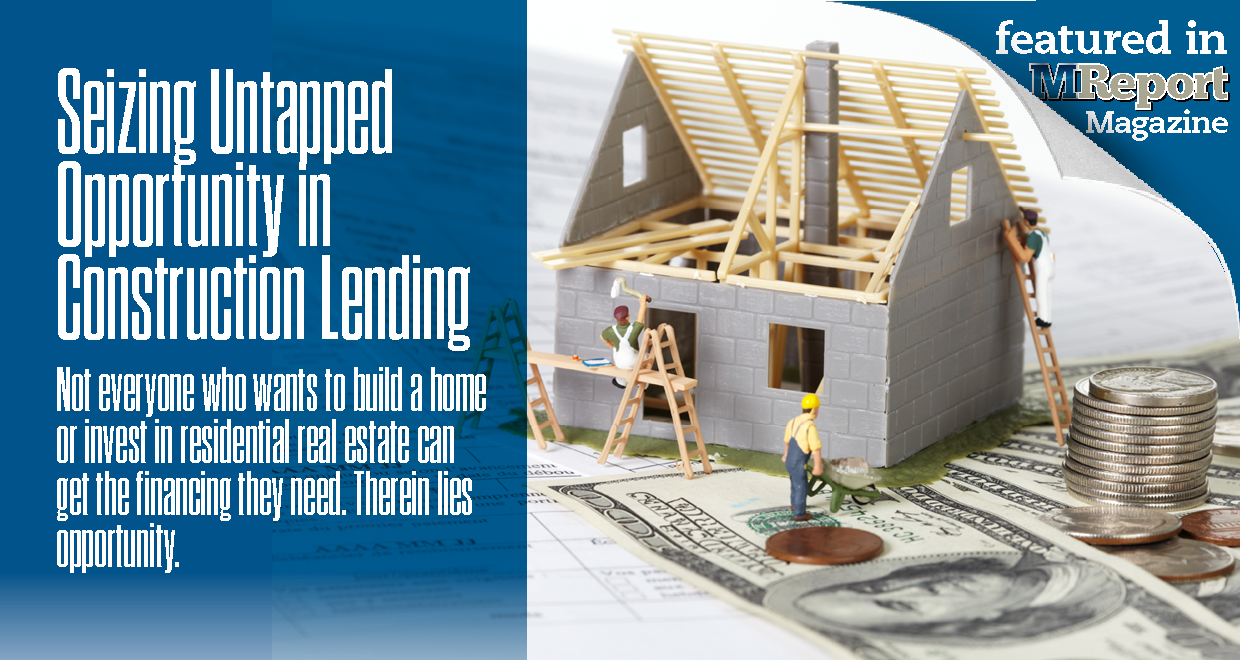
This piece originally appeared in the December 2022 edition of MReport magazine, online now.
It’s challenging to stay positive about the housing market these days, especially when confronted with headline after headline about soaring mortgage rates and plummeting home sales. On the other hand, if you’re a veteran of market cycles, you know there are always opportunities to keep business flowing despite the higher rates in mortgages and a nadir in home sales.
One lending opportunity with the strongest long-term potential is construction lending—even despite the current low activity in newly built homes. The problem? Not everyone who wants to build a home or invest in residential real estate can get the financing they need. Still, as originators begin to think outside the box regarding new lending options, this picture is starting to change.
Housing Stress Grows
No bones about it—the market for new homes is struggling mightily under the weight of higher interest rates. In fact, except for a brief moment during the pandemic, the National Association of Home Builders (NAHB)/Wells Fargo Housing Market Index recently dropped to its lowest level in 10 years.
Meanwhile, new housing starts fell 8.1% in September to the lowest level in two years, according to the Census Bureau’s numbers.
The market is even causing some builders to sell newly constructed homes to private equity firms—at a discount.
When one takes a closer look at the homebuilding market, all is not quite as gloomy as headlines make it seem. For one thing, the costs of construction and labor availability are holding steady.
Plus, people who desire a new home usually plan it out for some time and aren’t easily swayed from those plans when rates rise.
In fact, my company continues to find people interested in financing for new home construction.
However, the bigger picture is that the U.S. is experiencing a housing shortage of epic proportions, and ultimately, the only way to solve this problem is to build new homes. According to the National Association of Realtors’ most recent numbers, the United States has a shortage of 5.5 million homes across most major metros, particularly Chicago, Los Angeles, New York, and San Francisco. New housing has simply failed to keep pace with new household formations, and the impact is being felt in markets of all sizes.
For example, near our headquarters, Intel is currently building a $20 billion manufacturing site near Columbus, Ohio, that will bring 20,000 new jobs to the region at an average salary of $135,000 per year. This doesn’t include additional jobs from Intel vendors who are also relocating to the area. A report funded by the Building Industry Association of Central Ohio recently found that the Columbus region needs to double its home construction over the next decade to meet the area’s housing demands.
No Qualified Borrower Left Behind
When fewer people are buying homes, the smart thing to do is to look for niches. And if you haven’t given much thought to construction loans, now is the perfect time to offer borrowers as many options as possible, including agency construction loans, jumbo construction loans, construction loans with float down-rate options, and more.
Even if housing inventory issues were resolved tomorrow, too many borrowers are having trouble financing a new home because they don’t qualify using traditional guidelines. As a result, those who otherwise have both the ability and the willingness to repay a construction loan are left standing on the sidelines because of rigid, agency-oriented qualification standards, inflexible processes, and complex loan programs. A large segment of this group consists of self-employed Americans and business owners, who continue to increase in numbers.
According to the U.S. Bureau of Labor Statistics, there were 9.6 million Americans who were self-employed in August of this year, which was up nearly 1% from July.
As an originator, few things are more demoralizing than having a motivated client and not being able to find the right financing for them. Fortunately, we have a few options that can get more buyers into their dream homes—specifically, non-QM construction loan products.
These products, which combine the expanded borrower criteria typical in non-QM loans along with a single-close construction loan, are quickly growing in popularity among self-employed borrowers, business owners, and real estate investors seeking to build their dream home or rental property. As with a growing number of traditional construction loans, there’s only one closing, too. Borrowers can finance the construction of their project at zero interest and lock in their permanent loan rate within 60 days of closing.
Of course, the FHA offers a one-time close, a construction-to-permanent loan for people who want to build their own homes and don’t have perfect credit. The FHA loan, however, is limited to primary residences under the agency’s loan limits and its qualifying guidelines are much more stringent than non-QM products.
With a non-QM construction loan, borrowers can get up to $2 million in financing for the construction of primary residences, vacation homes, or investment properties. If they have decent credit, they can finance up to 80% of the property’s value, and up to 85% of the value with an excellent score, and not pay any mortgage insurance.
Investors can also use these products and qualify on a debt service coverage ratio (DSCR) basis. In such cases, we will look at a conservative estimate of the proposed rents for the property and compare that to the principal and interest (P&I) payment. If the P&I is lower than the proposed rents, they can qualify, regardless of their other income and liabilities.
In other words, the property is being qualified, not the borrower. This makes non-QM construction loans a terrific option for the first-time investor who wants to build a rental property and help with the nation’s housing shortage. At the same time, it can serve as an alternate investment to an already uncertain stock market coping with Fed rate hikes.
Another advantage to these products is that they appeal to all builders. While most large home developers have their own mortgage companies, not all of these mortgage companies typically provide non-QM loans. In some markets where there is inventory but not many homebuyers, builders like to see more financing options for borrowers. Most are happy to build for customers who have other types of loans like non-QM construction products.
Non-QM construction loans can also be used to buy almost any type of residential property, including non-warrantable condos and even duplexes, regardless of the type of financing from the other buyer. They can even be used on manufactured homes.
While there are typically prepayment penalties for these products, borrowers can avoid them by paying a slightly higher rate, too.
How to Take the Wheel
While non-QM construction loans would seem to appeal to only a minority of borrowers, our own loan officers have had no trouble finding people for whom this type of financing is a perfect fit. If a lender or originator has a moderate-sized book of business, chances are someone in their client database could use non-QM construction financing. The number of potential clients for these products is likely to grow, too.
Of course, construction loans still aren’t the simplest to originate. For this reason, originators who want to take advantage of them to keep business flowing need a competent wholesale partner that has in-depth experience on all types of construction loans. That includes agency and non-QM single-close construction to permanent loans, construction loans with rate cap options, jumbo construction loans, and construction-only loans. And they need to choose a wholesale partner wisely.
For example, some lenders that do construction loans outsource a lot of the administrative functions involved with originating them, such as approving builders and managing funding draws. These processes can lead to significant delays and borrower frustration when not done correctly and expediently. The wise path is to find a wholesale partner that manages these processes in-house, so lenders have some measure of control over them and a source for accountability.
Also, keep in mind how a potential wholesale partner qualifies borrowers. Many people looking to build a home will go first to a local bank, which tend to be more conservative and tighter in their lending guidelines. Independent mortgage banks, on the other hand, are generally more flexible and willing to work with borrowers who have slightly higher debt ratios or other factors that weigh into their overall financial picture. It’s also smart to partner with a lender that has experience qualifying and underwriting homebuilders to ensure whatever company builds the home has a strong performance record.
While times have quickly changed, all originators should ensure they have access to every loan product under the sun, so they are ready when they encounter borrowers who need a special type of financing. If you truly want to serve every client who wants to buy a home and can qualify, construction loans, including non-QM options, are a great tool for getting more business in today’s environment and are likely to be much more valuable down the road.
The late comedian Milton Berle once quipped, “If opportunity doesn’t knock, build a door.” For unserved borrowers looking to build real estate with nontraditional financing, the door has now been built. All that’s left to do is open it.

 theMReport.com Your trusted source for mortgage banking news
theMReport.com Your trusted source for mortgage banking news









